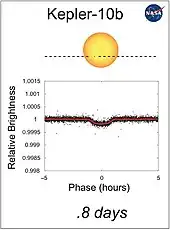Kepler-10b
Kepler-10b is the first confirmed terrestrial planet to have been discovered outside the Solar System by the Kepler Space Telescope.[6] Discovered after several months of data collection during the course of the NASA-directed Kepler Mission, which aims to discover Earth-like planets crossing in front of their host stars, the planet's discovery was announced on January 10, 2011. Kepler-10b has a mass of 3.72±0.42 Earth masses and a radius of 1.47 Earth radii. However, it lies extremely close to its star, Kepler-10, and as a result is too hot to support life as we know it. Its existence was confirmed using measurements from the W.M. Keck Observatory in Hawaii.
 Size comparison of Kepler-10b with Earth | |
| Discovery[1] | |
|---|---|
| Discovered by | Batalha et al. |
| Discovery date | January 10, 2011 |
| Transit (Kepler Mission) | |
| Orbital characteristics | |
| 0.01684 +0.00032 −0.00034[1] AU | |
| Eccentricity | 0[1] |
| 0.837495[1] d 20.0999 h | |
| Inclination | 84.4[1] |
| Semi-amplitude | 3.3 +0.8 −1.0[1] |
| Star | Kepler-10[2] |
| Physical characteristics | |
Mean radius | 1.47+0.03 −0.02[3] R🜨 |
| Mass | 3.72±0.42[4] M🜨 |
Mean density | 6.46±0.73 g/cm3[4] |
| 15 m/s2 (49 ft/s2)[3] | |
| Albedo | 0.5 |
| Temperature | 1,833 K (1,560 °C; 2,840 °F) (day side) 50 K (−223.2 °C; −369.7 °F) (night side)[5] |
Nomenclature and history
Kepler-10, the star that hosts Kepler-10b, is located 560 light-years from the Solar System in the Draco constellation. It is approximately the same size as the Sun, with an estimated age of 12 billion years.[7] Planet Kepler-10b was the first planet to be discovered in the orbit of its star. For this, it was designated the star's b planet. The star, in turn, was named for the Kepler Mission, a NASA-led operation aimed at discovering terrestrial planets that transit, or cross in front of, their host stars with respect to Earth.[8] The planet's discovery was announced to the public on January 10, 2011.[9]

The transit method of discovering exoplanets relies upon carefully monitoring the brightness of a star. If a planet is present and crosses the line of sight between Earth and the star, the star will dim at a regular interval by an amount that depends upon the radius of the transiting planet. In order to measure the mass of a planet, and rule out other phenomena that can mimic the presence of a planet transiting a star, candidate transiting planets are followed up with the radial velocity method of detecting extrasolar planets.[10]
Kepler-10b's discovery was based on eight months of data collected with the Kepler telescope from May 2009 to January 2010. The planet's first transits were observed in July 2009. According to the collected data, Kepler-10 dimmed by one part in ten thousand every 0.83 days.[11][12] Kepler-10 was the first star in the field of view of the Kepler telescope identified as capable of harboring a small transiting planet, and was considered a high priority target for ground-based radial velocity observations intended to confirm the mass of Kepler-10b. Radial velocity measurements with the Keck I telescope taken intermittently between August 2009 and August 2010 revealed a periodic Doppler shift in the spectrum of Kepler-10 consistent with a planet of the nature observed by Kepler, confirming the planet's existence and allowing its mass to be determined.[1][11] The planet's discovery was announced to the public on January 10, 2011.[9]
In September 2011, the detection of secondary transit and phases were announced. This allowed to determine the temperature and albedo of the planet. This is the first terrestrial exoplanet with observed phases. Detection of phases was possible due to extreme day/night side temperature variations and the amount of starlight the planet receives due to its proximity to the host star.[13]
Reaction
Kepler-10b's discovery excited astronomers, who hoped to use data about it to inquire into the formation and structure that terrestrial, Earth-size planets tend to have in common.[14] Diana Valencia at the University of Côte d'Azur in Nice, France considered the planet more of a "super-Mercury" than a super-Earth, granted its physical characteristics.[15]
Characteristics

Kepler-10b is most noted for its rocky surface. It has a diameter 1.47 times that of the Earth.[3] The mass of Kepler-10b is 3.72±0.42 times that of Earth and the average density is 6.46±0.73 g cm−3.[4] It orbits its star, Kepler-10, in less than a day, at less than a twentieth of the distance from Mercury to the Sun. Its surface temperature on the star lit side is approximately 1833 K,[16] which is as hot as a blast furnace and hot enough to melt iron.[12]
Though CoRoT-7b was discovered before Kepler-10b and has been claimed to be rocky, there is more room for other interpretations in the case of CoRoT-7b's composition than there is for Kepler-10b, due to its highly uncertain mass — for example, it could be predominantly water rather than rock and iron.[12]
Kepler-10b is tidally locked to its parent star and has extreme variations in temperature between day and night sides. It also reflects about half of the starlight it receives. One possible explanation for the high Bond albedo could be that Kepler-10b is a coreless rocky planet with surface magma oceans rich in iron oxides.[17]
See also
References
- Batalha, Natalie M.; et al. (2011). "Kepler's First Rocky Planet: Kepler-10b". The Astrophysical Journal. 729 (1): 27. arXiv:1102.0605. Bibcode:2011ApJ...729...27B. doi:10.1088/0004-637X/729/1/27. S2CID 55059000.
- "Summary Table of Kepler Discoveries". NASA. 2010-08-26. Archived from the original on 2010-05-27. Retrieved 2010-09-01.
- The Kepler-10 planetary system revisited by HARPS-N: A hot rocky world and a solid Neptune-mass planet, Xavier Dumusque, Aldo S. Bonomo, Raphaelle D. Haywood, Luca Malavolta, Damien Segransan, Lars A. Buchhave, Andrew Collier Cameron, David W. Latham, Emilio Molinari, Francesco Pepe, Stephane Udry, David Charbonneau, Rosario Cosentino, Courtney D. Dressing, Pedro Figueira, Aldo F. M. Fiorenzano, Sara Gettel, Avet Harutyunyan, Keith Horne, Mercedes Lopez-Morales, Christophe Lovis, Michel Mayor, Giusi Micela, Fatemeh Motalebi, Valerio Nascimbeni, David F. Phillips, Giampaolo Piotto, Don Pollacco, Didier Queloz, Ken Rice, Dimitar Sasselov, Alessandro Sozzetti, Andrew Szentgyorgyi, Chris Watson, (Submitted on 30 May 2014)
- , Weiss L. M., et al., 2016, Astrophys. J., 819, 83
- The orbital phases and secondary transit of Kepler-10b - A physical interpretation based on the Lava-ocean planet model : Daniel Rouan, Hans J. Deeg, Olivier Demangeon, Benjamin Samuel, Céline Cavarroc, Bruce Fegley, Alain Léger
- "BBC News". BBC. 2010-01-10. Retrieved 2010-11-01.
- "Kepler-10b". NASA. 2011-01-10. Archived from the original on 2011-07-21. Retrieved 2010-01-15.
- "Mission overview". Kepler and K2. NASA. 13 April 2015. Retrieved 3 December 2017.
- Dennis Overbye (10 January 2011). "Kepler-10b, a Lethally Hot Exoplanet, Is Discovered". New York Times. Retrieved 6 March 2011.
- Seager, S.; Mallen‐ornelas, G. (2003). "A Unique Solution of Planet and Star Parameters from an Extrasolar Planet Transit Light Curve". The Astrophysical Journal. 585 (2): 1038–1055. arXiv:astro-ph/0206228. Bibcode:2003ApJ...585.1038S. doi:10.1086/346105. S2CID 14274640.
- "NASA'S Kepler Mission Discovers Its First Rocky Planet". NASA. 2011-01-10. Retrieved 2011-01-10.
- Grossman, Lisa (2010-01-10). "Kepler Finds First Definitively Rocky Exoplanet". Wired. Archived from the original on 2014-06-02. Retrieved 2011-01-15.
- The orbital phases and secondary transit of Kepler-10b - A physical interpretation based on the Lava-ocean planet model : Daniel Rouan, Hans J. Deeg, Olivier Demangeon, Benjamin Samuel, Céline Cavarroc, Bruce Fegley, Alain Léger
- Dan Vergano (10 January 2011). "Kepler's rocky exoplanet reaction round-up". Science Fair. USA Today. Retrieved 11 March 2011.
- Ron Cowen (12 February 2011). "New Planet Small But Tough". ScienceNews. Retrieved 11 March 2011.
- "Kepler Discoveries: Kepler-10b". Kepler @ NASA. 2011-01-10. Archived from the original on 2011-07-21. Retrieved 2011-01-12.
- Modirrousta-Galian, D., Ito, Y. and Micela, G., (2020). Exploring super-Earth surfaces: Albedo of near-airless magma ocean planets and topography. Icarus, p.114175.


.jpg.webp)